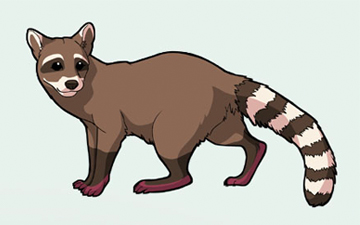The Crab-eating Raccoon (Procyon cancrivorus) is a species of raccoon native to marshy and jungle areas of Central andSouth America (including Trinidad and Tobago). It is found from Costa Rica south through most areas of South America east of the Andes down to northern Argentina and Uruguay.[1] That it is called the crab-eating raccoon does not mean that only this species will eat crabs, as the common raccoon will also seek and eat crabs where they are available.
The Crab-eating Raccoon eats crab, lobster, and other crustaceans, but is an omnivore and its diet also includes, for example, small amphibians, turtle eggs, and fruits. It resembles its northern cousin, the Common Raccoon, in having a bushy ringed tail and “bandit mask” of fur around its eyes. The crab-eating raccoon appears smaller and more streamlined than the common raccoon due to its much shorter fur, though it is of roughly similar dimensions. Head and body length is 41 to 60 centimetres (16 to 24 in), tail length is 20 to 42 cm (8 to 17 in), height at the shoulder is about 23 cm (9 in), and weights range from 2 to 12 kg (4 to 26 lb). Males are usually larger than the females.
The crab-eating raccoon is solitary and nocturnal. It is almost always found near streams, lakes and rivers.
(From Wikipedia, November 14th, 2010)
—
Crab-eating raccoons are nocturnal, omnivorous/frugivorous animals. Body weights range from 3 to 7 kg. Body lengths are reported as being between 54 and 65 cm, with the tail comprising 25 to 38 cm of the total length. Males tend to be larger than the females.
Procyon cancrivoruss can be found in a variety of habitats, including primary and secondary growth forest. Procyon cancrivorus makes use of habitats ranging from the forest of Ilanos, to the xeric chaco vegetation, and even the Amazon rainforests. As long as there are water, food, and places to hide and den, this raccoon will adapt. However, P. cancrivorus seems somewhat more restricted than P. lotor in habitat preferences. Procyon cancrivorous occupies areas around bodies of water, such as swamps, lakes, lagoons, and ocean beaches. Where both species overlap, crab-eating raccoons mainly occupy lands surrounding inland rivers, whereas northern raccoons occupy swamps and beaches.
For the most part, P. cancrivorus is omnivorous, but fruit has been observed to be the main part of its diet. Crab-eating raccoons consume a variety of foods, including invertebrates, crustaceans, insects, nuts, vegetables, fish, frogs, and small turtles. Olfaction, vision, and their sense of touch are used to identify and capture food. The diet may change with season and food availability. (De La Rosa and Nocke, 2000; Feldhamer, Thompson, and Chapman, 2003)
Crab-eating raccoons have good hearing capabilities, and are keen to strange noises. Even though they are color blind, they have excellent nighttime vision. Their tactile senses are what really set them apart from other carnivores. This tactile sense allows them to identify food items better than any other senses. There has been 13 different vocalizations recognized, 7 of which involved the mother and young. Although not specifically reported for this species, it is likely that, as in other mammals, scent cues play some role in reproduction and identification of individuals. (Feldhamer, Thompson, and Chapman, 2003)
(From EOL via ADW, November 14th, 2010)
—




